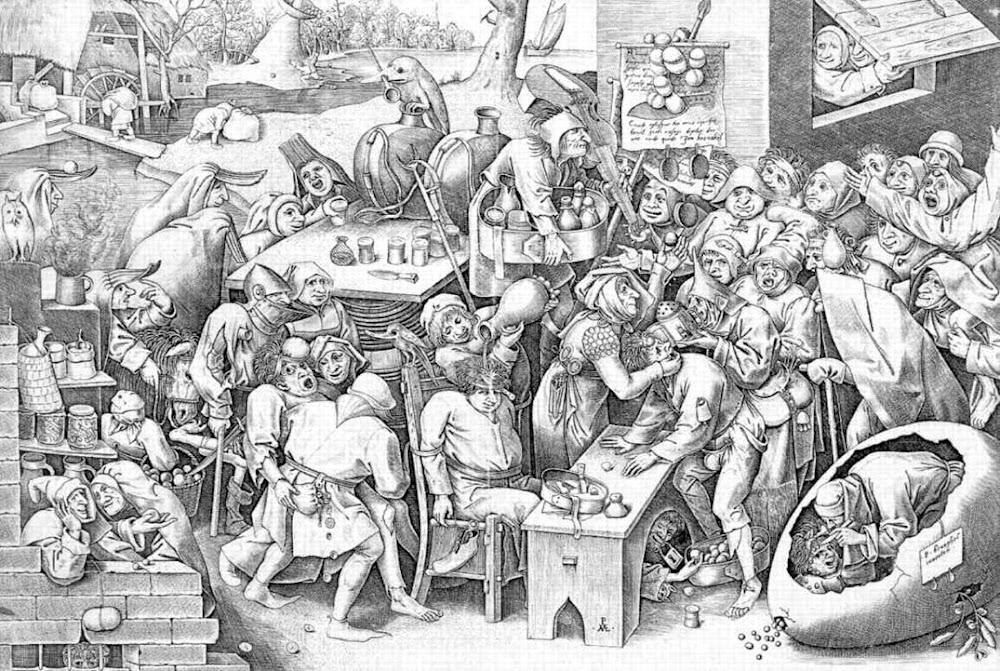Where circumstance permits I’ve been singing my version of Juan del Encina‘s Villançico contrahaziendo a los mocaros que sienpre van ynportunando a los peregrinos con demandas (1520s?), and I’m gradually trying to figure out what it all means. Who, for example, are the mocaros, always plaguing pilgrims with their pleas?
Alan D. Corré and Roberto Rossetti in their translation (the site is indispensable for anyone at all interested in Lingua Franca) suggest that they are ruffians, but I’ve yet to meet a word like mocaro in LF or in related language which is used in that way.
Quickly discarding frivolous thoughts of authentic street Arabs in the then great port of Mocha in the Yemen, and of Egyptian mountains, I imagined snot-nosed urchins: the Latin for nasal slime mūcus/muccus gives Spanish moco, snot, whence mocoso, etc..
Virtually all mocaro ghits are for some Adolf Hipster fashion brand, but Frederick Starr‘s Catalogue of a collection of objects illustrating the folklore of Mexico (1899) contains a short list of forfeits used in children’s games, one of which is santo mocaro, which he translates as nose blowing.
With an alternative spelling this saint turns up in Quevedo’s Entremés de los refranes del viejo celoso (ca. 1620). Towards the end the elderly cuckold and proverb-abuser pleads for mercy, invoking several pseudo-saints, and among them the one who lived on in industrial Mexico:
Misericordia, señor,
yo lo doy por recibido.
Valedme agora, valedme,
¡oh santos deste distrito!
¡Oh señor santo Mocarro!
¡Oh señor Santiliprisco!
¡Señor santo de Pajares,
de todos tan conocido,
libradme de Pero Grullo!
St Snotnose & Co (St Nobody, St. Falsehood, St. Onion, St. Slap-arse, St. Flea, St. Hairy, St. Have-not, St. Punch-up, St. Prison…) also turn up in late medieval French and Dutch parodic hagiographies, and then there’s Chaucer’s “Seynt Idiot, lord of thise foles alle.”
In the 15th century mock sermon, Dit es van den scijtstoel, the macaronic preacher, curiously enthroned on a shite-stool, invokes Snottolf (snot-wolf?), a specialist in post-evacuation dingleberry management, who has experimented with tools such as mussel shells and hay.
In the Brueghel-v/d Heyden print St Snotneus is a quack who for the appropriate fee will relieve all kei (=millstone or other boulder) sufferers (i.e. lunatics; you can also hang millstones round your neck):
Compt alle keyaerts die met der keyen zijt ghequelt,
‘Tsy rijck ofte arm, niemant wtghesteken,
Ick Meester Snottolf sal u helpen om ghelt
[Ziet] mijn Conste aen desen keyaert is ghebleken.
So yes, I think Encina’s mocaros are santos mocaros, in-your-face money-for-miracle-workers.
Now sit back and watch the price of fish.
Similar posts
- How to perform El retablo de Maese Pedro aka El retablo de la libertad de Melisendra in Don Quixote with one puppeteer and a narrator/bottler
Whether Cervantes saw it or not, it is possible as he describes. - Por qué El Organillero va a cantar reggaetón
… pero boicoteará a los - Did the house that Jack built come from Spain?
Or, How to cook the old lady who swallowed a fly without stooping to cannibalism. Cumulative songs (and monstrous nested stuffing - Monkeys here, monkeys there, monkeys everywhere
Victor Hugo puts on his black - Two versions of Flann O’Brien’s “The workman’s friend”
With some relevant chunks of Henry

Comments